外研版(2019) 必修第二册 Unit 4 Stage and Screen 非谓语动词2做定语状语课件(32张)
文档属性
| 名称 | 外研版(2019) 必修第二册 Unit 4 Stage and Screen 非谓语动词2做定语状语课件(32张) |  | |
| 格式 | zip | ||
| 文件大小 | 471.8KB | ||
| 资源类型 | 教案 | ||
| 版本资源 | 外研版(2019) | ||
| 科目 | 英语 | ||
| 更新时间 | 2022-07-28 16:43:08 | ||
图片预览



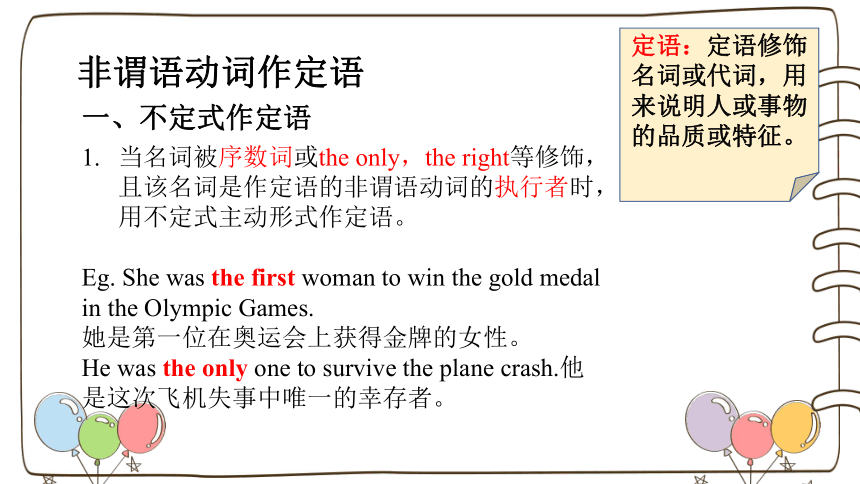
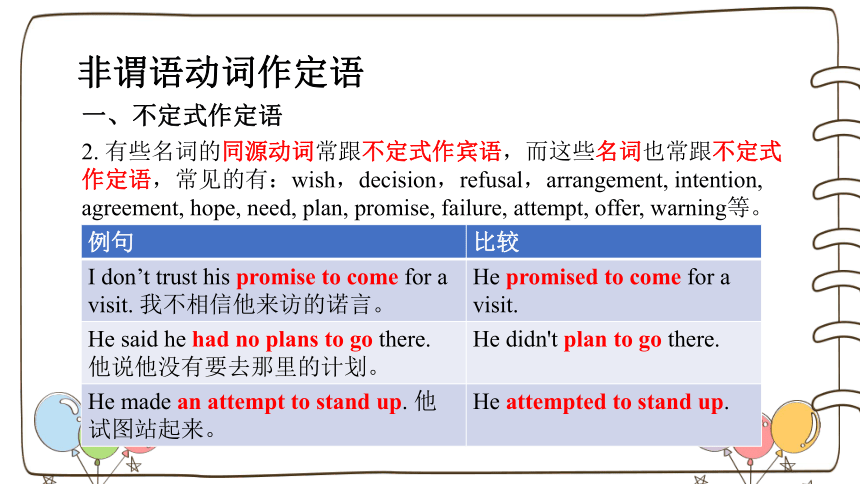
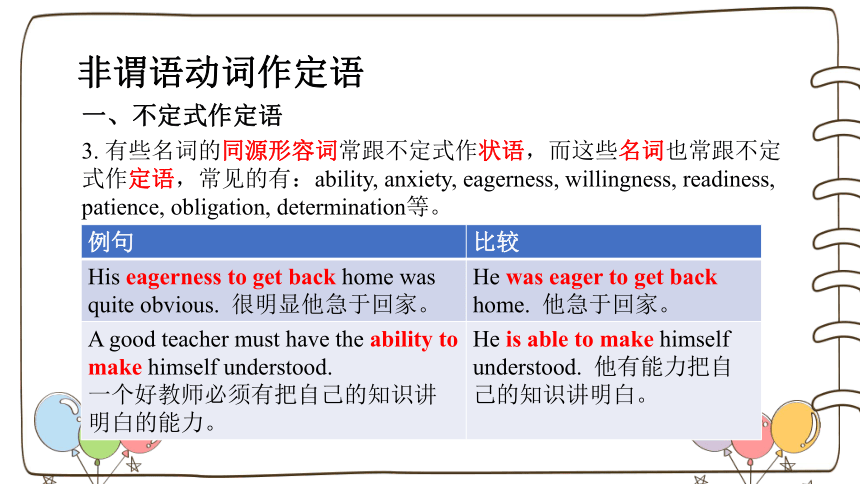
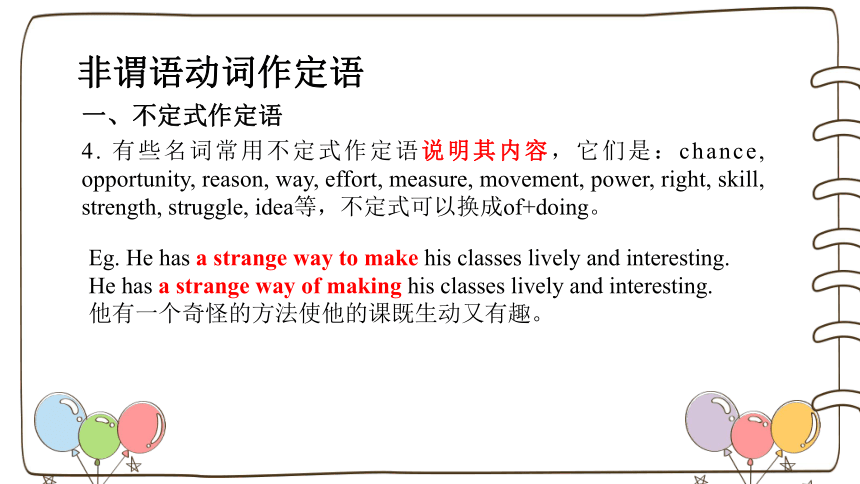

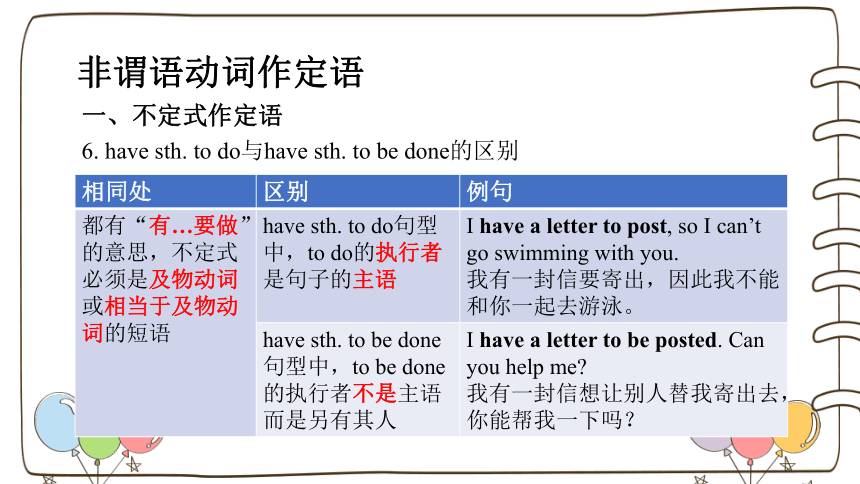
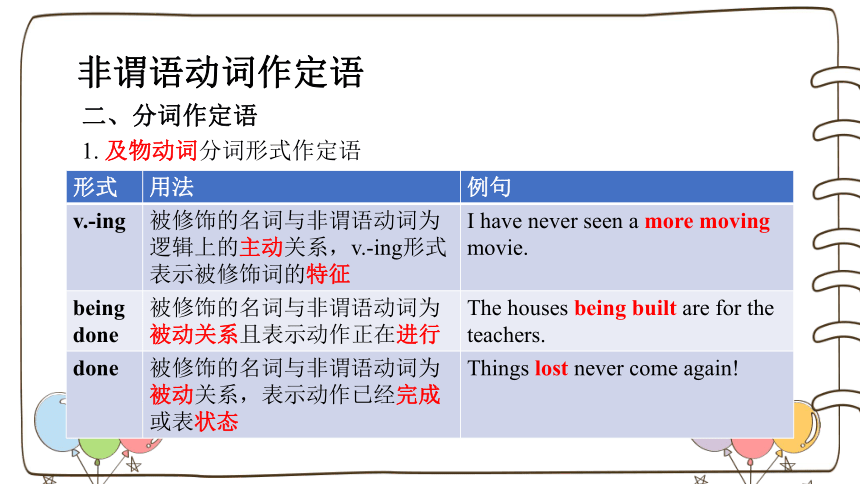
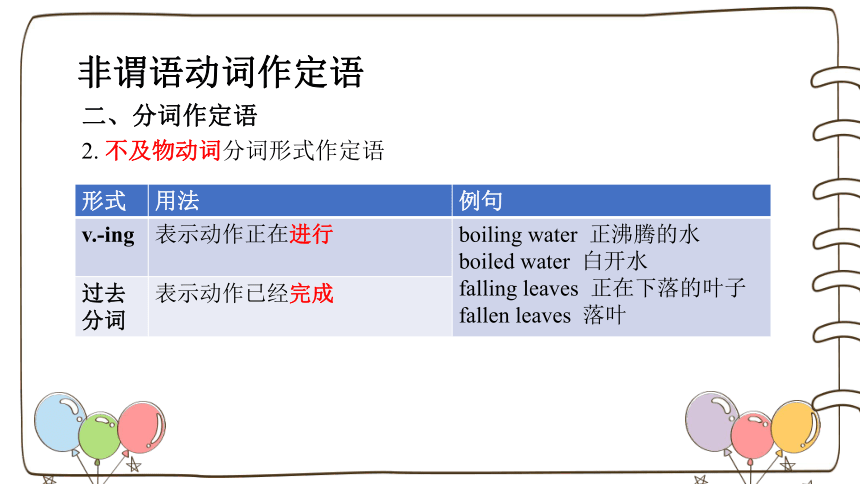
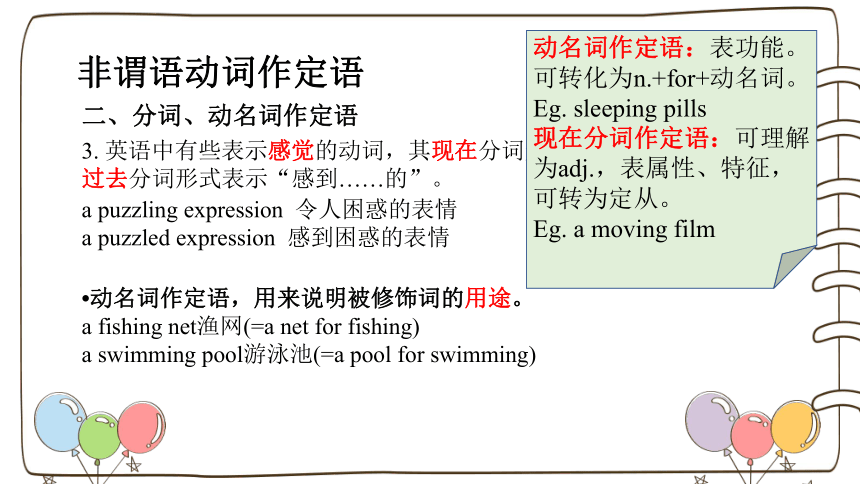
文档简介
(共32张PPT)
2
0
2
2
非谓语动词(2)
做定语、状语
非谓语动词概述
一个简单句只能有一个动词做谓语,这个动词叫谓语动词;在这个简单句中,其他没有做谓语的动词,不管有多少个,都不能做谓语,这些动词就叫非谓语动词。
形式:动词不定式to do ;动名词doing ;分词(现在分词doing , 过去分词done)
功能:谓语动词作谓语,非谓语动词作除谓语以外的成分,主宾表定状补。
非谓语动词
做定语
非谓语动词作定语
一、不定式作定语
定语:定语修饰名词或代词,用来说明人或事物的品质或特征。
当名词被序数词或the only,the right等修饰,且该名词是作定语的非谓语动词的执行者时,用不定式主动形式作定语。
Eg. She was the first woman to win the gold medal in the Olympic Games.
她是第一位在奥运会上获得金牌的女性。
He was the only one to survive the plane crash.他是这次飞机失事中唯一的幸存者。
非谓语动词作定语
一、不定式作定语
2. 有些名词的同源动词常跟不定式作宾语,而这些名词也常跟不定式作定语,常见的有:wish,decision,refusal,arrangement, intention, agreement, hope, need, plan, promise, failure, attempt, offer, warning等。
例句 比较
I don’t trust his promise to come for a visit. 我不相信他来访的诺言。 He promised to come for a visit.
He said he had no plans to go there. 他说他没有要去那里的计划。 He didn't plan to go there.
He made an attempt to stand up. 他试图站起来。 He attempted to stand up.
非谓语动词作定语
一、不定式作定语
3. 有些名词的同源形容词常跟不定式作状语,而这些名词也常跟不定式作定语,常见的有:ability, anxiety, eagerness, willingness, readiness, patience, obligation, determination等。
例句 比较
His eagerness to get back home was quite obvious. 很明显他急于回家。 He was eager to get back home. 他急于回家。
A good teacher must have the ability to make himself understood. 一个好教师必须有把自己的知识讲明白的能力。 He is able to make himself
understood. 他有能力把自己的知识讲明白。
非谓语动词作定语
一、不定式作定语
4. 有些名词常用不定式作定语说明其内容,它们是:chance, opportunity, reason, way, effort, measure, movement, power, right, skill, strength, struggle, idea等,不定式可以换成of+doing。
Eg. He has a strange way to make his classes lively and interesting.
He has a strange way of making his classes lively and interesting.
他有一个奇怪的方法使他的课既生动又有趣。
非谓语动词作定语
一、不定式作定语
5. 中心词是作定语的不定式的动作的执行者,动词不定式所表示的动作一般后于谓语动词或在将来发生。
Eg. He had no photographs to remind him of the past.
他没有照片来使他回顾过去的事情。(remind后于had。)
Is there anybody to carry on the work
有人要继续这项工作吗 (to carry on表示将来)
非谓语动词作定语
一、不定式作定语
6. have sth. to do与have sth. to be done的区别
相同处 区别 例句
都有“有…要做” 的意思,不定式必须是及物动词或相当于及物动 词的短语 have sth. to do句型中,to do的执行者是句子的主语 I have a letter to post, so I can’t go swimming with you.
我有一封信要寄出,因此我不能和你一起去游泳。
have sth. to be done句型中,to be done的执行者不是主语而是另有其人 I have a letter to be posted. Can
you help me
我有一封信想让别人替我寄出去,你能帮我一下吗?
非谓语动词作定语
二、分词作定语
1. 及物动词分词形式作定语
形式 用法 例句
v.-ing 被修饰的名词与非谓语动词为逻辑上的主动关系,v.-ing形式表示被修饰词的特征 I have never seen a more moving movie.
being done 被修饰的名词与非谓语动词为被动关系且表示动作正在进行 The houses being built are for the teachers.
done 被修饰的名词与非谓语动词为被动关系,表示动作已经完成或表状态 Things lost never come again!
非谓语动词作定语
二、分词作定语
2. 不及物动词分词形式作定语
形式 用法 例句
v.-ing 表示动作正在进行 boiling water 正沸腾的水
boiled water 白开水
falling leaves 正在下落的叶子
fallen leaves 落叶
过去分词 表示动作已经完成
非谓语动词作定语
二、分词、动名词作定语
3. 英语中有些表示感觉的动词,其现在分词形式表示“令人…的”,过去分词形式表示“感到……的”。
a puzzling expression 令人困惑的表情
a puzzled expression 感到困惑的表情
动名词作定语,用来说明被修饰词的用途。
a fishing net渔网(=a net for fishing)
a swimming pool游泳池(=a pool for swimming)
动名词作定语:表功能。可转化为n.+for+动名词。
Eg. sleeping pills
现在分词作定语:可理解为adj.,表属性、特征,可转为定从。
Eg. a moving film
技巧点拨
非谓语动词作定语
提示词
解题法
逻辑关系解题法
固定句型
to do
被修饰名词的同源动词用不定式作宾语
被修饰名词的同源形容词用不定式作状语
被修饰词被the only, the next, the last等修饰,且与提示词为逻辑上的主动关系
表示被修饰词的用途:doing
被修饰词与提示词主动:
表将来:to do; 表过去或现在:doing
被修饰词与提示词被动:
表完成:done;
表将来:to be done;
表进行:being done
练习:非谓语作定语
They made a decision ____________(put) off the meeting until next week.
The building ________________(construct) will be completed next year.
There are still many problems ____________(solve) before we are ready for a long stay on the Moon.
It’s necessary to drink ____________(boil) water every day.
I am fond of the plan ____________(go) on a trip to Hainan next month.
Her eagerness ____________(work) will please the boss.
Volunteer gives you a chance ____________(change)lives, including your own.
to put
being constructed
to be solved
boiled
to go
to work
to change
非谓语动词
做状语
非谓语动词作状语
状语概念:
状语修饰动词、形容词、副词以及全句。位置灵活。用来表示行为发生的方式、条件、目的、时间、地点、程度等。
不定式、分词作状语的基本原则:
不定式,分词作状语时,其逻辑主语必须与句子的主语保持一致,即不定式、分词作状语,必须和句子的主语存在逻辑上的主动或被动关系,否则一般不能使用不定式、分词作状语。
非谓语动词作状语
一、不定式作状语
1. 不定式作目的状语
形式 位置 例句
to+动词原形 句首,句中 In the show, the hosts and guests should complete tasks at a given place to win the race.
in order to+动词原形 句首,句中 In order to make a study of kangaroos, he went to Australia.
so as to+动词原形 句中 Her mother plans to fly to Beijing at least four times a year so as to visit her.
非谓语动词作状语
一、不定式作状语
2. 不定式作结果状语
形式 意思 例句
to+动词原形 结果… What have I done to offend you
我做什么了结果把你冒犯了?
only to+动词原形 结果却…(表示意外的或事与愿违的结果) Jane hurried back only to find
that her mother had left.
so+形容词/副词+as to+动词原形 如此…以至于 I’m not so stupid as to write it down.
我不至于愚蠢到把它写下来。
非谓语动词作状语
一、不定式作状语
2. 不定式作结果状语
形式 意思 例句
such+名词+as to+动词原形 如此…以至于 It was such a loud noise as to wake everyone in the house.
enough to+ 动词原形 足够…能… He is old enough to join the army.
too...to+ 动词原形 太…而不能… I’m too tired to stay up late.
非谓语动词作状语
一、不定式作状语
3. 不定式作原因状语
用法 常用词 例句
形容词作表语时,后面可接不定式作原因状语,用以说明产生这种情绪的原因 happy, glad, sorry, anxious, proud, disappointed ,angry, surprised, ready, delighted, pleased You will never know how happy I was to see her yesterday.
非谓语动词作状语
一、不定式作状语
4. 不定式的主动形式表被动意义
用法 常用词 例句
在“主语+系动词+表语(形容词)+to do”结构中,句子的主语与动词不定式有逻辑上的被动关系,且形容词表示主语的特征或性质,这时需用不定式的主动形式表示被动意义 easy, hard, difficult, important, impossible, interesting, pleasant, nice, comfortable, safe, dangerous This question is easy to answer.
这个问题容易回答。
This book is difficult to understand.
这本书很难理解。
非谓语动词作状语
二、分词作状语
1. 分词作状语时其形式的选择
形式 意义
v.-ing (doing) 与句子主语为逻辑上的主动关系,与句子谓语动词动作同时发生,或基本上同时发生
Eg. Having dinner, she told me a story.
having+v.-ed (having done) 与句子主语为逻辑上的主动关系,先于谓语动词动作发生
Eg. Having learned French for many years, now he can live in France alone.
非谓语动词作状语
二、分词作状语
1. 分词作状语时其形式的选择
形式 意义
v.-ed (done) 与句子主语为逻辑上的被动关系,表完成
Eg. Seen from the mountain top, our village is really beautiful.
being+v.-ed(being done) 与句子主语为逻辑上的被动关系,且与谓语动词动作同时发生
Eg. Being barbecued, the meat can't be eaten now.
having been+v.-ed (having been done) 与句子主语为逻辑上的被动关系,且先于谓语动词动作发生
Eg. Having been told many times, he finally understood it.
非谓语动词作状语
二、分词作状语
2. 分词作状语的句法功能
形式 意义
时间状语 Seeing from the top of the hill, we can see the park clearly.
原因状语 Having been bitten by a snake, she was frightened of it.
条件状语 Turning right, you will find the station.
非谓语动词作状语
二、分词作状语
2. 分词作状语的句法功能
形式 意义
结果状语 He died, leaving nothing for his wife.
让步状语 Having failed many times, he didn’t lose heart.
伴随状语 She came in the room, followed by her husband.
非谓语动词作状语
三、独立成分作状语
定义 常见的独立成分 例句
有些分词或不定式短语 作状语,其形式的选择 不受上下文的影响,被 称为独立成分 generally speaking 一般来说 frankly speaking 坦白地说 judging from/by... 根据…来判断 considering.../taking... into consideration 考虑到… to tell you the truth 说实话 compared to/with与…相比 Judging from his accent, he is from Hong Kong.
从他的口音判断,他
是香港人。
To tell you the truth,
I am a little tired.
说实话,我有点累。
非谓语动词作状语
三、独立成分作状语
定义 常见的独立成分 例句
有些分词或不定式短语 作状语,其形式的选择 不受上下文的影响,被 称为独立成分 generally speaking 一般来说 frankly speaking 坦白地说 judging from/by... 根据…来判断 considering.../taking... into consideration 考虑到… to tell you the truth 说实话 compared to/with与…相比 Judging from his accent, he is from Hong Kong.
从他的口音判断,他
是香港人。
To tell you the truth,
I am a little tired.
说实话,我有点累。
非谓语动词作状语
三、独立主格结构
1. 独立主格结构的定义:
非谓语动词作状语时,其逻辑主语应和句子主语保持一致。但有时非谓语动词带有自己的逻辑主语,并在句子中作状语,我们称之为独立主格结构。
非谓语动词作状语
三、独立主格结构
2. 独立主格结构的特点:
①独立主格结构的逻辑主语与句子的主语不同,它独立存在;
Eg. Weather permitting, we are going to visit you tomorrow.
②独立主格结构中作逻辑主语的名词或代词与后面的分词或不定式是逻辑上的主动或被动关系;
Eg. The test finished, we began our holiday.
③一般用逗号把独立主格结构与句子主干分开。
非谓语动词作状语
三、独立主格结构
3. 独立主格结构的构成:
①名词/代词+分词;
Eg. Weather permitting, we are going to visit you tomorrow.
②名词/代词+不定式;
Eg. The four of us agreed on a division of labor, each to translate a quarter of the book. 我们四人同意分工干,每人翻译全书的四分之一。
③with/without+名词/代词+分词/不定式。
Eg. With a boy leading the way, they started towards the village.
由一个小男孩领着路,他们朝那个村子去了。
技巧点拨
非谓语动词作状语
主语与提示词为逻辑上的被动关系
表示动作还未发生-to be done
表示动作已经发生-done
表示动作正在进行-being done
主语与提示词为逻辑上的主动关系
to do-目的,结果,原因
doing-时间,条件,原因,让步,伴随,结果(非意外)
only to do-意料之外
练习:非谓语作状语
1. Anxiously, she took the dress out of the package and tried it on, only
(find) it didn’t fit.
2. (spend) the past year as an exchange student in Hong Kong, Linda appears maturer than those of her age.
3. (attract) by the beauty of nature, the girl decided to spend another two days on the farm.
4. They are easy (care) for and make great presents.
5. (receive) a reply, he decided to call her.
没有收到回复,他决定打给她。
6. The work (do), we went home. 工作完成后,我们才回家。
7. The man felt very happy with so many children (sit) around him.
to find
Having spent
Attracted
to care
在“主语+系动词+表语(形容词)+to do”结构中,句子的主语与动词不定式有逻辑上的被动关系,且形容词表示主语的特征或性质,这时需用不定式的主动形式表示被动意义
Eg. This book is difficult to understand.
Not having received
done
sitting
2
0
2
2
非谓语动词(2)
做定语、状语
非谓语动词概述
一个简单句只能有一个动词做谓语,这个动词叫谓语动词;在这个简单句中,其他没有做谓语的动词,不管有多少个,都不能做谓语,这些动词就叫非谓语动词。
形式:动词不定式to do ;动名词doing ;分词(现在分词doing , 过去分词done)
功能:谓语动词作谓语,非谓语动词作除谓语以外的成分,主宾表定状补。
非谓语动词
做定语
非谓语动词作定语
一、不定式作定语
定语:定语修饰名词或代词,用来说明人或事物的品质或特征。
当名词被序数词或the only,the right等修饰,且该名词是作定语的非谓语动词的执行者时,用不定式主动形式作定语。
Eg. She was the first woman to win the gold medal in the Olympic Games.
她是第一位在奥运会上获得金牌的女性。
He was the only one to survive the plane crash.他是这次飞机失事中唯一的幸存者。
非谓语动词作定语
一、不定式作定语
2. 有些名词的同源动词常跟不定式作宾语,而这些名词也常跟不定式作定语,常见的有:wish,decision,refusal,arrangement, intention, agreement, hope, need, plan, promise, failure, attempt, offer, warning等。
例句 比较
I don’t trust his promise to come for a visit. 我不相信他来访的诺言。 He promised to come for a visit.
He said he had no plans to go there. 他说他没有要去那里的计划。 He didn't plan to go there.
He made an attempt to stand up. 他试图站起来。 He attempted to stand up.
非谓语动词作定语
一、不定式作定语
3. 有些名词的同源形容词常跟不定式作状语,而这些名词也常跟不定式作定语,常见的有:ability, anxiety, eagerness, willingness, readiness, patience, obligation, determination等。
例句 比较
His eagerness to get back home was quite obvious. 很明显他急于回家。 He was eager to get back home. 他急于回家。
A good teacher must have the ability to make himself understood. 一个好教师必须有把自己的知识讲明白的能力。 He is able to make himself
understood. 他有能力把自己的知识讲明白。
非谓语动词作定语
一、不定式作定语
4. 有些名词常用不定式作定语说明其内容,它们是:chance, opportunity, reason, way, effort, measure, movement, power, right, skill, strength, struggle, idea等,不定式可以换成of+doing。
Eg. He has a strange way to make his classes lively and interesting.
He has a strange way of making his classes lively and interesting.
他有一个奇怪的方法使他的课既生动又有趣。
非谓语动词作定语
一、不定式作定语
5. 中心词是作定语的不定式的动作的执行者,动词不定式所表示的动作一般后于谓语动词或在将来发生。
Eg. He had no photographs to remind him of the past.
他没有照片来使他回顾过去的事情。(remind后于had。)
Is there anybody to carry on the work
有人要继续这项工作吗 (to carry on表示将来)
非谓语动词作定语
一、不定式作定语
6. have sth. to do与have sth. to be done的区别
相同处 区别 例句
都有“有…要做” 的意思,不定式必须是及物动词或相当于及物动 词的短语 have sth. to do句型中,to do的执行者是句子的主语 I have a letter to post, so I can’t go swimming with you.
我有一封信要寄出,因此我不能和你一起去游泳。
have sth. to be done句型中,to be done的执行者不是主语而是另有其人 I have a letter to be posted. Can
you help me
我有一封信想让别人替我寄出去,你能帮我一下吗?
非谓语动词作定语
二、分词作定语
1. 及物动词分词形式作定语
形式 用法 例句
v.-ing 被修饰的名词与非谓语动词为逻辑上的主动关系,v.-ing形式表示被修饰词的特征 I have never seen a more moving movie.
being done 被修饰的名词与非谓语动词为被动关系且表示动作正在进行 The houses being built are for the teachers.
done 被修饰的名词与非谓语动词为被动关系,表示动作已经完成或表状态 Things lost never come again!
非谓语动词作定语
二、分词作定语
2. 不及物动词分词形式作定语
形式 用法 例句
v.-ing 表示动作正在进行 boiling water 正沸腾的水
boiled water 白开水
falling leaves 正在下落的叶子
fallen leaves 落叶
过去分词 表示动作已经完成
非谓语动词作定语
二、分词、动名词作定语
3. 英语中有些表示感觉的动词,其现在分词形式表示“令人…的”,过去分词形式表示“感到……的”。
a puzzling expression 令人困惑的表情
a puzzled expression 感到困惑的表情
动名词作定语,用来说明被修饰词的用途。
a fishing net渔网(=a net for fishing)
a swimming pool游泳池(=a pool for swimming)
动名词作定语:表功能。可转化为n.+for+动名词。
Eg. sleeping pills
现在分词作定语:可理解为adj.,表属性、特征,可转为定从。
Eg. a moving film
技巧点拨
非谓语动词作定语
提示词
解题法
逻辑关系解题法
固定句型
to do
被修饰名词的同源动词用不定式作宾语
被修饰名词的同源形容词用不定式作状语
被修饰词被the only, the next, the last等修饰,且与提示词为逻辑上的主动关系
表示被修饰词的用途:doing
被修饰词与提示词主动:
表将来:to do; 表过去或现在:doing
被修饰词与提示词被动:
表完成:done;
表将来:to be done;
表进行:being done
练习:非谓语作定语
They made a decision ____________(put) off the meeting until next week.
The building ________________(construct) will be completed next year.
There are still many problems ____________(solve) before we are ready for a long stay on the Moon.
It’s necessary to drink ____________(boil) water every day.
I am fond of the plan ____________(go) on a trip to Hainan next month.
Her eagerness ____________(work) will please the boss.
Volunteer gives you a chance ____________(change)lives, including your own.
to put
being constructed
to be solved
boiled
to go
to work
to change
非谓语动词
做状语
非谓语动词作状语
状语概念:
状语修饰动词、形容词、副词以及全句。位置灵活。用来表示行为发生的方式、条件、目的、时间、地点、程度等。
不定式、分词作状语的基本原则:
不定式,分词作状语时,其逻辑主语必须与句子的主语保持一致,即不定式、分词作状语,必须和句子的主语存在逻辑上的主动或被动关系,否则一般不能使用不定式、分词作状语。
非谓语动词作状语
一、不定式作状语
1. 不定式作目的状语
形式 位置 例句
to+动词原形 句首,句中 In the show, the hosts and guests should complete tasks at a given place to win the race.
in order to+动词原形 句首,句中 In order to make a study of kangaroos, he went to Australia.
so as to+动词原形 句中 Her mother plans to fly to Beijing at least four times a year so as to visit her.
非谓语动词作状语
一、不定式作状语
2. 不定式作结果状语
形式 意思 例句
to+动词原形 结果… What have I done to offend you
我做什么了结果把你冒犯了?
only to+动词原形 结果却…(表示意外的或事与愿违的结果) Jane hurried back only to find
that her mother had left.
so+形容词/副词+as to+动词原形 如此…以至于 I’m not so stupid as to write it down.
我不至于愚蠢到把它写下来。
非谓语动词作状语
一、不定式作状语
2. 不定式作结果状语
形式 意思 例句
such+名词+as to+动词原形 如此…以至于 It was such a loud noise as to wake everyone in the house.
enough to+ 动词原形 足够…能… He is old enough to join the army.
too...to+ 动词原形 太…而不能… I’m too tired to stay up late.
非谓语动词作状语
一、不定式作状语
3. 不定式作原因状语
用法 常用词 例句
形容词作表语时,后面可接不定式作原因状语,用以说明产生这种情绪的原因 happy, glad, sorry, anxious, proud, disappointed ,angry, surprised, ready, delighted, pleased You will never know how happy I was to see her yesterday.
非谓语动词作状语
一、不定式作状语
4. 不定式的主动形式表被动意义
用法 常用词 例句
在“主语+系动词+表语(形容词)+to do”结构中,句子的主语与动词不定式有逻辑上的被动关系,且形容词表示主语的特征或性质,这时需用不定式的主动形式表示被动意义 easy, hard, difficult, important, impossible, interesting, pleasant, nice, comfortable, safe, dangerous This question is easy to answer.
这个问题容易回答。
This book is difficult to understand.
这本书很难理解。
非谓语动词作状语
二、分词作状语
1. 分词作状语时其形式的选择
形式 意义
v.-ing (doing) 与句子主语为逻辑上的主动关系,与句子谓语动词动作同时发生,或基本上同时发生
Eg. Having dinner, she told me a story.
having+v.-ed (having done) 与句子主语为逻辑上的主动关系,先于谓语动词动作发生
Eg. Having learned French for many years, now he can live in France alone.
非谓语动词作状语
二、分词作状语
1. 分词作状语时其形式的选择
形式 意义
v.-ed (done) 与句子主语为逻辑上的被动关系,表完成
Eg. Seen from the mountain top, our village is really beautiful.
being+v.-ed(being done) 与句子主语为逻辑上的被动关系,且与谓语动词动作同时发生
Eg. Being barbecued, the meat can't be eaten now.
having been+v.-ed (having been done) 与句子主语为逻辑上的被动关系,且先于谓语动词动作发生
Eg. Having been told many times, he finally understood it.
非谓语动词作状语
二、分词作状语
2. 分词作状语的句法功能
形式 意义
时间状语 Seeing from the top of the hill, we can see the park clearly.
原因状语 Having been bitten by a snake, she was frightened of it.
条件状语 Turning right, you will find the station.
非谓语动词作状语
二、分词作状语
2. 分词作状语的句法功能
形式 意义
结果状语 He died, leaving nothing for his wife.
让步状语 Having failed many times, he didn’t lose heart.
伴随状语 She came in the room, followed by her husband.
非谓语动词作状语
三、独立成分作状语
定义 常见的独立成分 例句
有些分词或不定式短语 作状语,其形式的选择 不受上下文的影响,被 称为独立成分 generally speaking 一般来说 frankly speaking 坦白地说 judging from/by... 根据…来判断 considering.../taking... into consideration 考虑到… to tell you the truth 说实话 compared to/with与…相比 Judging from his accent, he is from Hong Kong.
从他的口音判断,他
是香港人。
To tell you the truth,
I am a little tired.
说实话,我有点累。
非谓语动词作状语
三、独立成分作状语
定义 常见的独立成分 例句
有些分词或不定式短语 作状语,其形式的选择 不受上下文的影响,被 称为独立成分 generally speaking 一般来说 frankly speaking 坦白地说 judging from/by... 根据…来判断 considering.../taking... into consideration 考虑到… to tell you the truth 说实话 compared to/with与…相比 Judging from his accent, he is from Hong Kong.
从他的口音判断,他
是香港人。
To tell you the truth,
I am a little tired.
说实话,我有点累。
非谓语动词作状语
三、独立主格结构
1. 独立主格结构的定义:
非谓语动词作状语时,其逻辑主语应和句子主语保持一致。但有时非谓语动词带有自己的逻辑主语,并在句子中作状语,我们称之为独立主格结构。
非谓语动词作状语
三、独立主格结构
2. 独立主格结构的特点:
①独立主格结构的逻辑主语与句子的主语不同,它独立存在;
Eg. Weather permitting, we are going to visit you tomorrow.
②独立主格结构中作逻辑主语的名词或代词与后面的分词或不定式是逻辑上的主动或被动关系;
Eg. The test finished, we began our holiday.
③一般用逗号把独立主格结构与句子主干分开。
非谓语动词作状语
三、独立主格结构
3. 独立主格结构的构成:
①名词/代词+分词;
Eg. Weather permitting, we are going to visit you tomorrow.
②名词/代词+不定式;
Eg. The four of us agreed on a division of labor, each to translate a quarter of the book. 我们四人同意分工干,每人翻译全书的四分之一。
③with/without+名词/代词+分词/不定式。
Eg. With a boy leading the way, they started towards the village.
由一个小男孩领着路,他们朝那个村子去了。
技巧点拨
非谓语动词作状语
主语与提示词为逻辑上的被动关系
表示动作还未发生-to be done
表示动作已经发生-done
表示动作正在进行-being done
主语与提示词为逻辑上的主动关系
to do-目的,结果,原因
doing-时间,条件,原因,让步,伴随,结果(非意外)
only to do-意料之外
练习:非谓语作状语
1. Anxiously, she took the dress out of the package and tried it on, only
(find) it didn’t fit.
2. (spend) the past year as an exchange student in Hong Kong, Linda appears maturer than those of her age.
3. (attract) by the beauty of nature, the girl decided to spend another two days on the farm.
4. They are easy (care) for and make great presents.
5. (receive) a reply, he decided to call her.
没有收到回复,他决定打给她。
6. The work (do), we went home. 工作完成后,我们才回家。
7. The man felt very happy with so many children (sit) around him.
to find
Having spent
Attracted
to care
在“主语+系动词+表语(形容词)+to do”结构中,句子的主语与动词不定式有逻辑上的被动关系,且形容词表示主语的特征或性质,这时需用不定式的主动形式表示被动意义
Eg. This book is difficult to understand.
Not having received
done
sitting
